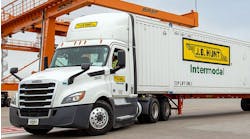Class 8 order drop reflects lack of confidence in supply chain
A drop in North American Class 8 net orders reflects a continued lack of confidence in the supply chain and growing pressure for new commercial vehicle order activity, according to two trucking research firms.
FTR Transportation Intelligence reports preliminary North American Class 8 net orders dropped in November to 9,500 units, down 41% from October and down 82% year-over-year. Orders were the lowest for the month of November since 1995, according to FTR.
Preliminary Class 8 net orders in November, according to ACT Research, were 9,800 units, while Classes 5-7 net orders dropped to 21,500 units, both representing lower sequential and year-over-year readings. ACT Research stated it will publish complete industry data for November by mid-December.
See also: Waiting for the dam to burst: Pent-up demand held back by supply chain
“Long backlog lead times resulting from ongoing supply-side constraints continue to pressure new order activity,” Kenny Vieth, ACT’s president and senior analyst, explained. “With backlogs stretching into late 2022 and still no clear visibility about the easing of the ‘everything’ shortage, modest November order results suggest the OEMs are continuing to take a more cautious approach to booking orders so as not to extend the cycle of customer expectations management.”
“Importantly, we reiterate, with critical economic and industry demand drivers at, or near, record levels, industry strength is exhibited in long backlog lead times, rather than seasonally weak orders,” Vieth added. “Looking to October data, the last full month of data in hand, the Class 8 backlog was nearly 281,000 units and at October’s build rate, the backlog-to-build ratio was 14.6 months, illustrating demand versus supply-side challenges.”
FTR reiterated that the low order total in November is not due to a lack of demand for new equipment, which is very high, but rather due to the uncertainty in the supply chain. Class 8 orders now total a “still-impressive” 393,000 units for the previous 12 months, FTR said.
OEMs remain reluctant to increase total backlogs with so much uncertainty about the supply chain, FTR noted. Component deliveries, especially semiconductors, have been unreliable since March. OEMs booked a huge number of orders a year ago, expecting to be able to build at full capacity throughout 2021, but parts and components shortages prevented them from completing many of these trucks.
“The low order numbers in November in no way are representative of total demand,” Don Ake, VP of commercial vehicles for FTR, pointed out. “The weak volumes are because OEMs are managing their backlogs very carefully. After overbooking almost every month in 2021, the OEMs are being extremely meticulous about scheduling commitments in 2022.
“This strategy will continue until the supply-chain situation improves,” Ake continued. “Once the OEMs are confident, they can obtain the necessary production inputs, they will boost production and enter more orders. Backlogs remain at sturdy levels, but OEMs don’t want them much higher until they know their manufacturing capacity.”
Ake also pointed out that demand for new trucks is at record levels, with “tremendous” pent-up demand generated in 2020 and 2021.
“Spot rates are at record levels, and contract rates are rising,” he added. “Prices for used trucks are also at record highs. And when the manufacturing sector of the economy gets past the supply chain crisis, there will be even more freight to haul.”




